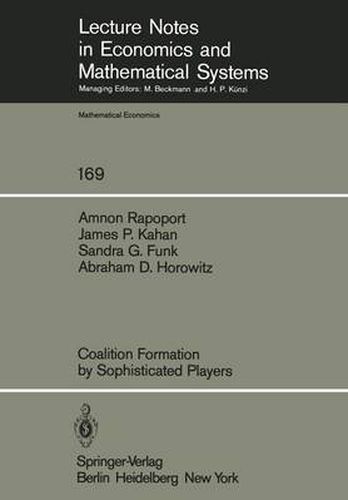Readings Newsletter
Become a Readings Member to make your shopping experience even easier.
Sign in or sign up for free!
You’re not far away from qualifying for FREE standard shipping within Australia
You’ve qualified for FREE standard shipping within Australia
The cart is loading…






This title is printed to order. This book may have been self-published. If so, we cannot guarantee the quality of the content. In the main most books will have gone through the editing process however some may not. We therefore suggest that you be aware of this before ordering this book. If in doubt check either the author or publisher’s details as we are unable to accept any returns unless they are faulty. Please contact us if you have any questions.
The three major aims of the present study were to (a) test some of the major game-theoretic solutions for n-person games in characteristic function form with data obtained from rational players; (b) locate, assess, and explain differences between sophisticated and naive subjects in coalition frequencies and payoff disbursements; and © provide a common data base for bargaining process analyses and testing of both present and future models. To this end, five quartets of subjects each partici pated in 16 different coalition formation tasks presented as computer-controlled, four-person, characteristic function games with sidepayments. All 20 subjects (a) were relatively mathematically sophisticated, (b) were familiar with the major solution concepts for characteristic function games, © could safely assume that their co-players were equally sophisticated and knowledgeable, and (d) possessed a high motivation to maximize reward. The results showed that (a) sophisticated players are less restricted than naive players in coalition choice, (b) their payoffs are less variable and less ~galitarian, © these differences between the two populations of sub jects increase with the complexity of the game, and (d) for III the four-person, mDstly non-superadditive games played in the present experiment, the bargaining set M~i) accounts more accurately for payoff disbursements than do the competitive bargaining set H~i), the kernel K, and Selten’s equal share analysis.
$9.00 standard shipping within Australia
FREE standard shipping within Australia for orders over $100.00
Express & International shipping calculated at checkout
This title is printed to order. This book may have been self-published. If so, we cannot guarantee the quality of the content. In the main most books will have gone through the editing process however some may not. We therefore suggest that you be aware of this before ordering this book. If in doubt check either the author or publisher’s details as we are unable to accept any returns unless they are faulty. Please contact us if you have any questions.
The three major aims of the present study were to (a) test some of the major game-theoretic solutions for n-person games in characteristic function form with data obtained from rational players; (b) locate, assess, and explain differences between sophisticated and naive subjects in coalition frequencies and payoff disbursements; and © provide a common data base for bargaining process analyses and testing of both present and future models. To this end, five quartets of subjects each partici pated in 16 different coalition formation tasks presented as computer-controlled, four-person, characteristic function games with sidepayments. All 20 subjects (a) were relatively mathematically sophisticated, (b) were familiar with the major solution concepts for characteristic function games, © could safely assume that their co-players were equally sophisticated and knowledgeable, and (d) possessed a high motivation to maximize reward. The results showed that (a) sophisticated players are less restricted than naive players in coalition choice, (b) their payoffs are less variable and less ~galitarian, © these differences between the two populations of sub jects increase with the complexity of the game, and (d) for III the four-person, mDstly non-superadditive games played in the present experiment, the bargaining set M~i) accounts more accurately for payoff disbursements than do the competitive bargaining set H~i), the kernel K, and Selten’s equal share analysis.